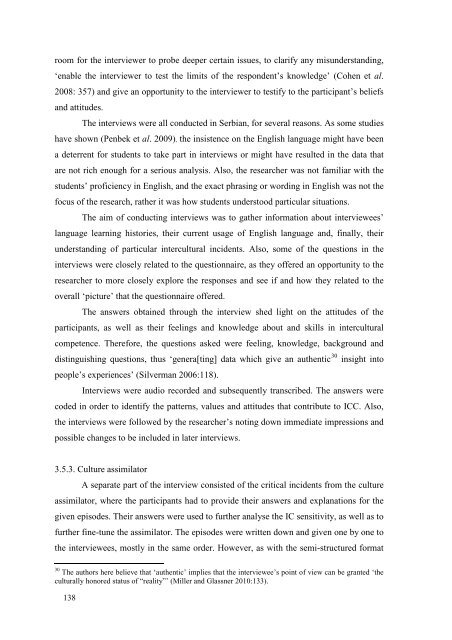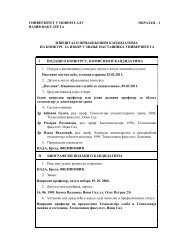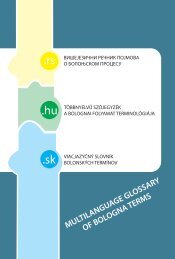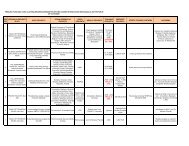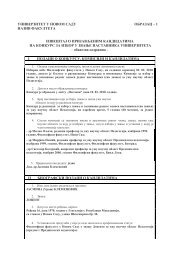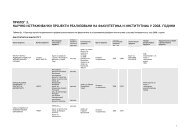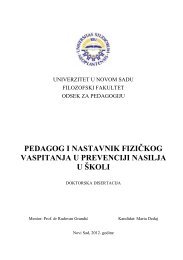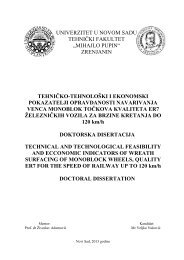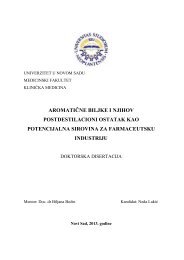Intercultural competence as an aspect of the communicative ...
Intercultural competence as an aspect of the communicative ...
Intercultural competence as an aspect of the communicative ...
Create successful ePaper yourself
Turn your PDF publications into a flip-book with our unique Google optimized e-Paper software.
oom for <strong>the</strong> interviewer to probe deeper certain issues, to clarify <strong>an</strong>y misunderst<strong>an</strong>ding,<br />
‘enable <strong>the</strong> interviewer to test <strong>the</strong> limits <strong>of</strong> <strong>the</strong> respondent’s knowledge’ (Cohen et al.<br />
2008: 357) <strong>an</strong>d give <strong>an</strong> opportunity to <strong>the</strong> interviewer to testify to <strong>the</strong> particip<strong>an</strong>t’s beliefs<br />
<strong>an</strong>d attitudes.<br />
The interviews were all conducted in Serbi<strong>an</strong>, for several re<strong>as</strong>ons. As some studies<br />
have shown (Penbek et al. 2009), <strong>the</strong> insistence on <strong>the</strong> English l<strong>an</strong>guage might have been<br />
a deterrent for students to take part in interviews or might have resulted in <strong>the</strong> data that<br />
are not rich enough for a serious <strong>an</strong>alysis. Also, <strong>the</strong> researcher w<strong>as</strong> not familiar with <strong>the</strong><br />
students’ pr<strong>of</strong>iciency in English, <strong>an</strong>d <strong>the</strong> exact phr<strong>as</strong>ing or wording in English w<strong>as</strong> not <strong>the</strong><br />
focus <strong>of</strong> <strong>the</strong> research, ra<strong>the</strong>r it w<strong>as</strong> how students understood particular situations.<br />
The aim <strong>of</strong> conducting interviews w<strong>as</strong> to ga<strong>the</strong>r information about interviewees’<br />
l<strong>an</strong>guage learning histories, <strong>the</strong>ir current usage <strong>of</strong> English l<strong>an</strong>guage <strong>an</strong>d, finally, <strong>the</strong>ir<br />
underst<strong>an</strong>ding <strong>of</strong> particular intercultural incidents. Also, some <strong>of</strong> <strong>the</strong> questions in <strong>the</strong><br />
interviews were closely related to <strong>the</strong> questionnaire, <strong>as</strong> <strong>the</strong>y <strong>of</strong>fered <strong>an</strong> opportunity to <strong>the</strong><br />
researcher to more closely explore <strong>the</strong> responses <strong>an</strong>d see if <strong>an</strong>d how <strong>the</strong>y related to <strong>the</strong><br />
overall ‘picture’ that <strong>the</strong> questionnaire <strong>of</strong>fered.<br />
The <strong>an</strong>swers obtained through <strong>the</strong> interview shed light on <strong>the</strong> attitudes <strong>of</strong> <strong>the</strong><br />
particip<strong>an</strong>ts, <strong>as</strong> well <strong>as</strong> <strong>the</strong>ir feelings <strong>an</strong>d knowledge about <strong>an</strong>d skills in intercultural<br />
<strong>competence</strong>. Therefore, <strong>the</strong> questions <strong>as</strong>ked were feeling, knowledge, background <strong>an</strong>d<br />
distinguishing questions, thus ‘genera[ting] data which give <strong>an</strong> au<strong>the</strong>ntic 30 insight into<br />
people’s experiences’ (Silverm<strong>an</strong> 2006:118).<br />
Interviews were audio recorded <strong>an</strong>d subsequently tr<strong>an</strong>scribed. The <strong>an</strong>swers were<br />
coded in order to identify <strong>the</strong> patterns, values <strong>an</strong>d attitudes that contribute to ICC. Also,<br />
<strong>the</strong> interviews were followed by <strong>the</strong> researcher’s noting down immediate impressions <strong>an</strong>d<br />
possible ch<strong>an</strong>ges to be included in later interviews.<br />
3.5.3. Culture <strong>as</strong>similator<br />
A separate part <strong>of</strong> <strong>the</strong> interview consisted <strong>of</strong> <strong>the</strong> critical incidents from <strong>the</strong> culture<br />
<strong>as</strong>similator, where <strong>the</strong> particip<strong>an</strong>ts had to provide <strong>the</strong>ir <strong>an</strong>swers <strong>an</strong>d expl<strong>an</strong>ations for <strong>the</strong><br />
given episodes. Their <strong>an</strong>swers were used to fur<strong>the</strong>r <strong>an</strong>alyse <strong>the</strong> IC sensitivity, <strong>as</strong> well <strong>as</strong> to<br />
fur<strong>the</strong>r fine-tune <strong>the</strong> <strong>as</strong>similator. The episodes were written down <strong>an</strong>d given one by one to<br />
<strong>the</strong> interviewees, mostly in <strong>the</strong> same order. However, <strong>as</strong> with <strong>the</strong> semi-structured format<br />
30 The authors here believe that ‘au<strong>the</strong>ntic’ implies that <strong>the</strong> interviewee’s point <strong>of</strong> view c<strong>an</strong> be gr<strong>an</strong>ted ‘<strong>the</strong><br />
culturally honored status <strong>of</strong> “reality”’ (Miller <strong>an</strong>d Gl<strong>as</strong>sner 2010:133).<br />
138


